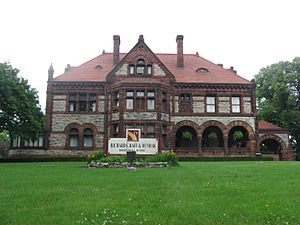Asa S. Bushnell (governor) facts for kids
Quick facts for kids
Asa Smith Bushnell
|
|
|---|---|
 |
|
| 40th Governor of Ohio | |
| In office January 13, 1896 – January 8, 1900 |
|
| Lieutenant | Asa W. Jones |
| Preceded by | William McKinley |
| Succeeded by | George K. Nash |
| Personal details | |
| Born | September 16, 1834 Rome, New York, U.S. |
| Died | January 15, 1904 (aged 69) Columbus, Ohio, U.S. |
| Resting place | Ferncliff Cemetery, Springfield, Ohio |
| Political party | Republican |
| Spouse | Ellen Ludlow |
| Children | 3 |
| Signature | |
| Military service | |
| Allegiance | United States of America Union |
| Branch/service | Union Army |
| Years of service | 1864 |
| Rank | Captain |
| Unit | 152nd Ohio Infantry |
| Battles/wars | American Civil War |
Asa Smith Bushnell I (born September 16, 1834 – died January 15, 1904) was a Republican politician from Ohio. He became the 40th Governor of Ohio. Before becoming governor, he was a successful businessman. He led the Warder, Bushnell and Glessner Company, which later joined with other companies to form International Harvester. He also served as president of the Springfield Gas Company and the First National Bank of Springfield.
Contents
Asa Bushnell's Life and Career
Bushnell was born in Rome, New York. When he was 17, he moved to Springfield, Ohio.
Serving in the Civil War
During the American Civil War, Bushnell helped create a group of soldiers for the 152nd Ohio Infantry. This group served for 100 days. Bushnell was their captain from May to September in 1864.
Entering Politics
In 1884, he was chosen as a Presidential elector for James G. Blaine. This meant he helped formally elect the president. As a business leader, Bushnell also became the head of the Ohio State Republican Party in 1885. He followed William McKinley as governor, serving two terms from 1896 to 1900.
Fighting Monopolies: The Valentine Anti-Trust Act
During Governor Bushnell's time, Ohio played an important role in stopping "trusts." Trusts were large groups of businesses that worked together to control prices and limit competition. This often hurt regular people by making things more expensive.
What the Act Did
The Valentine Anti-Trust Act was signed into law by Governor Bushnell. This law made it illegal for businesses to:
- Fix prices: This means businesses could not secretly agree on prices to make them higher.
- Limit production: This stopped companies from making less of a product to drive up its cost.
These actions helped businesses earn more money, but they made products more expensive for customers.
Taking on Standard Oil
Besides the Valentine Anti-Trust Act, Bushnell's attorney general also went after the Standard Oil Company in court. Standard Oil was a very large company that had a monopoly, meaning it controlled most of the oil business. Later, U.S. Senator John Sherman of Ohio introduced the Sherman Antitrust Act in 1890. This was the first major effort by the U.S. government to break up monopolies and trusts.
Asa Bushnell's Final Days
In January 1904, Bushnell traveled from his home in Springfield to Columbus. He went to attend the ceremony where Governor Myron T. Herrick was sworn into office. After the event, as he was getting into his carriage to go home, he became very ill. He died four days later at a hospital in Columbus. He was buried in Ferncliff Cemetery in Springfield on January 18, 1904.
Asa Bushnell's Family
Asa Bushnell married Ellen Ludlow in Springfield on September 17, 1857. They had three children: two daughters and one son. He was also a member of several groups, including the Masons, the Grand Army of the Republic (a group for Civil War veterans), and the Episcopal Church.
Bushnell's Home
Asa Bushnell and his wife built a large house in Springfield, Ohio. The house was designed in a style called Richardson Romanesque. This style uses heavy stone, round arches, and towers. The house was not designed by the famous architect Henry Hobson Richardson himself, but by his company shortly after he passed away.
Interestingly, both of Bushnell's business partners, Benjamin Head Warder and John Glessner, had hired Richardson to design their homes earlier. Their houses are the Warder Mansion in Washington, D.C., and the John J. Glessner House in Chicago. Glessner's house is considered one of Richardson's best designs.
Today, the Bushnell House is part of the East High Street Historic District in Springfield. This district is listed on the National Register of Historic Places, which means it is an important historical site.


